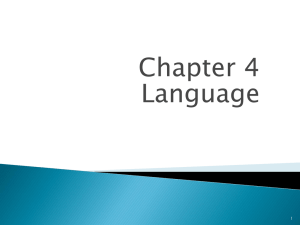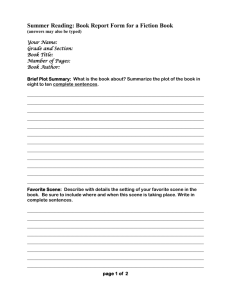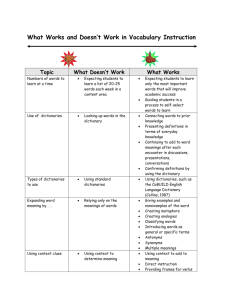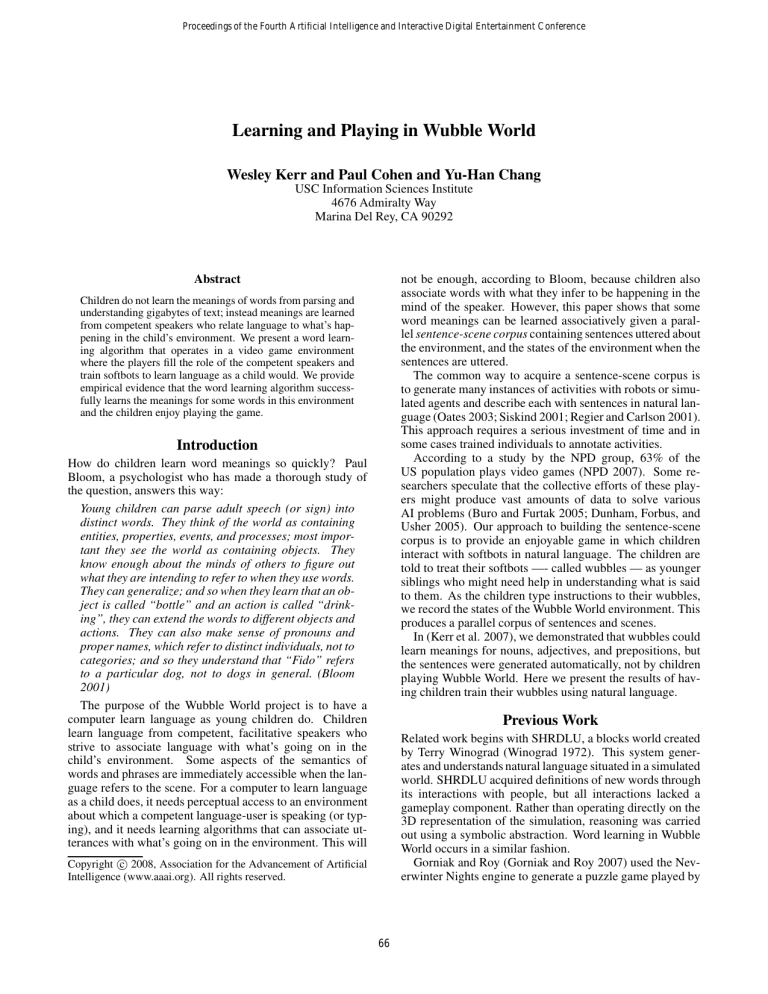
Proceedings of the Fourth Artificial Intelligence and Interactive Digital Entertainment Conference
Learning and Playing in Wubble World
Wesley Kerr and Paul Cohen and Yu-Han Chang
USC Information Sciences Institute
4676 Admiralty Way
Marina Del Rey, CA 90292
not be enough, according to Bloom, because children also
associate words with what they infer to be happening in the
mind of the speaker. However, this paper shows that some
word meanings can be learned associatively given a parallel sentence-scene corpus containing sentences uttered about
the environment, and the states of the environment when the
sentences are uttered.
The common way to acquire a sentence-scene corpus is
to generate many instances of activities with robots or simulated agents and describe each with sentences in natural language (Oates 2003; Siskind 2001; Regier and Carlson 2001).
This approach requires a serious investment of time and in
some cases trained individuals to annotate activities.
According to a study by the NPD group, 63% of the
US population plays video games (NPD 2007). Some researchers speculate that the collective efforts of these players might produce vast amounts of data to solve various
AI problems (Buro and Furtak 2005; Dunham, Forbus, and
Usher 2005). Our approach to building the sentence-scene
corpus is to provide an enjoyable game in which children
interact with softbots in natural language. The children are
told to treat their softbots —- called wubbles — as younger
siblings who might need help in understanding what is said
to them. As the children type instructions to their wubbles,
we record the states of the Wubble World environment. This
produces a parallel corpus of sentences and scenes.
In (Kerr et al. 2007), we demonstrated that wubbles could
learn meanings for nouns, adjectives, and prepositions, but
the sentences were generated automatically, not by children
playing Wubble World. Here we present the results of having children train their wubbles using natural language.
Abstract
Children do not learn the meanings of words from parsing and
understanding gigabytes of text; instead meanings are learned
from competent speakers who relate language to what’s happening in the child’s environment. We present a word learning algorithm that operates in a video game environment
where the players fill the role of the competent speakers and
train softbots to learn language as a child would. We provide
empirical evidence that the word learning algorithm successfully learns the meanings for some words in this environment
and the children enjoy playing the game.
Introduction
How do children learn word meanings so quickly? Paul
Bloom, a psychologist who has made a thorough study of
the question, answers this way:
Young children can parse adult speech (or sign) into
distinct words. They think of the world as containing
entities, properties, events, and processes; most important they see the world as containing objects. They
know enough about the minds of others to figure out
what they are intending to refer to when they use words.
They can generalize; and so when they learn that an object is called “bottle” and an action is called “drinking”, they can extend the words to different objects and
actions. They can also make sense of pronouns and
proper names, which refer to distinct individuals, not to
categories; and so they understand that “Fido” refers
to a particular dog, not to dogs in general. (Bloom
2001)
The purpose of the Wubble World project is to have a
computer learn language as young children do. Children
learn language from competent, facilitative speakers who
strive to associate language with what’s going on in the
child’s environment. Some aspects of the semantics of
words and phrases are immediately accessible when the language refers to the scene. For a computer to learn language
as a child does, it needs perceptual access to an environment
about which a competent language-user is speaking (or typing), and it needs learning algorithms that can associate utterances with what’s going on in the environment. This will
Previous Work
Related work begins with SHRDLU, a blocks world created
by Terry Winograd (Winograd 1972). This system generates and understands natural language situated in a simulated
world. SHRDLU acquired definitions of new words through
its interactions with people, but all interactions lacked a
gameplay component. Rather than operating directly on the
3D representation of the simulation, reasoning was carried
out using a symbolic abstraction. Word learning in Wubble
World occurs in a similar fashion.
Gorniak and Roy (Gorniak and Roy 2007) used the Neverwinter Nights engine to generate a puzzle game played by
c 2008, Association for the Advancement of Artificial
Copyright Intelligence (www.aaai.org). All rights reserved.
66
larger set of varied objects is placed in the room. The wubble
begins questioning the child about these objects, and in the
process gathers additional data with which to refine recently
learned concepts, such as “red” and “cube.” The wubble
gathers this information with assertions like: Click on all of
the red objects.
After this, the wubble and child are promoted to the Apple Room, which contains several objects differing in size,
shape, and color. On a platform in one corner of the room
is an apple. The child’s goal is to get her wubble to retrieve
the apple. The physics of Wubble World won’t let wubbles
jump as high as the platform, so the child must instruct her
wubble to build a staircase from the objects in the room.
The final room is the Sorting Room where the child works
with her wubble to line up the objects in the room from
tallest to shortest.
Children instruct their wubbles in English to perform
tasks. Through this interaction, the wubbles learn nouns
(box, cone), adjectives (red, tall), and spatial prepositions
that describe relations between objects (behind, left of). All
wubbles are provided with the meanings of a small set of
verbs a priori. So if a child says, “pick up the red cube,” the
wubble knows what “pick up” means and can perform the
action.
two people. Only one of the players was allowed to talk,
and all communication between the players was recorded.
The authors developed a software system that is able to
understand language after gathering data from several subjects solving the same task. This system can interface with
the original puzzle game and through voice communication
with the first player execute commands as the second player
would in the game. This approach of gathering data and
refining semantics is similar to ours, although we use an online model of word learning that allows instruction from a
teacher.
In a similar effort, Orkin and Roy (Orkin and Roy 2007)
developed an on-line social game between two people. The
interactions of the players took place in a virtual restaurant.
The authors gathered linguistic data from the players’ typed
messages, as well as scene descriptions such as character
positions, the actions the characters performed, and so on.
The authors refined the gathered data into a compact representation, called Plan Networks, that can accurately judge
typical behavior versus atypical behavior within the virtual
restaurant. The research generates large amounts of data,
but there has not been a signficant investment in learning the
meanings of words used within the environment.
Sankar and Gorin (Sankar and Gorin 1993) developed a
2D environment similar to Wubble World. It displayed a set
of objects in a scene, and provided an interface for interacting with a softbot represented onscreen as an eye. The
eye was directed towards objects in the scene using natural language. The system successfully learned 431 words
from over 1000 conversations, on-line, by adjusting a connectionist network. Other researchers worked with the connectionist paradigm to explore the symbol grounding problem (Schyns 1991; Plunkett et al. 1992; Gasser and Smith
1998; Regier 1996). Most of this research resulted in networks that were trained and tested, in batch, to associate
words with images. In this paper we present a different word
learning algorithm that learns on-line and also operates in a
3D environment.
Word Learning
Wubble word learning is illustrated in Figure 1. Word learning is perhaps a misleading phrase because what’s learned is
a concept, the name of which is a word or a phrase. Wubbles maintain simple, feature-based representations of concepts. For objects, the features are shape, color and size;
for prepositions, the features describe ways of dividing up
space. Each feature has an associated weight or probability
distribution, as shown in step 2 of Figure 1. For instance,
the weights associated with the feature values shape =
cylinder and color = blue are higher than the weights associated with shape = sphere and color = orange.
The wubble learns incrementally, on-line, by updating the
weights associated with each feature. When a wubble encounters a sentence, it parses it (step 1, Fig. 1) and retrieves
from memory the concepts that correspond to the words and
phrases in the sentence (step 2, Fig. 1). If a word is new,
the wubble creates a set of weight distributions, one for
each feature, initialized with a uniform distribution. Next,
the wubble imagines an object (or adjective, or preposition)
by sampling from the retrieved distributions of each feature.
Sampling is probabilistic, so there is a small probability that
the wubble will imagine a blue cone, say, instead of a blue
cylinder (the output of step 2, Fig. 1). It then compares the
imagined object with the objects in the scene, and it calculates scores for the correspondences between the imagined
object and those in the scene (step 3, Fig. 1). After that,
if the wubble is certain enough it has identified the referent
of the word or phrase, it acts. For instance, in the scene in
Figure 1, the wubble would go to the blue cylinder. However, if it remains uncertain about the referent of a word
or phrase, it asks the player to point to the referent (step 4,
Fig. 1). Then the wubble updates the feature representation
associated with the word or phrase to make it more like the
Problem Statement
We set out to design a game entertaining enough for children to play for its own sake, and that would also generate
a sentence-scene corpus. The result is Wubble World, an
on-line game environment where children play the role of
parents and softbots called wubbles play the role of infants.
Wubble World consists of several mini-game environments,
but this paper focuses on just one of them, the Wubble Room
mini-game, in which children direct their wubbles in natural
language to perform tasks. Before playing the game children
are told: “This is your wubble. It knows some English, but
not much. Often, when you tell it to do something, it will
ask you what you mean. You will be given a task for your
wubble to do, and you will have to tell it in English how to
do the task.”
The Wubble Room mini-game has three separate rooms:
The Introduction Room is where children familiarize their
wubbles with different objects. The children can interact
with their wubbles and four other objects in the room. After a short period of interaction in the Introduction Room, a
67
Figure 1: The steps involved in learning word meanings in Wubble Room.
the wubbles’ ability to understand English improved, and
this kept some children engaged.
To get enough interactions between children and wubbles
we merged all students’ sessions together — each session
being a sequence of sentences typed by the child to her wubble. For each sentence, the word learning algorithm worked
on learning the meaning of each constituent noun, adjective,
and preposition. A word and its associated scene constitute
a single training instance.
We selected 23 words from the children’s transcripts and
specified an “ideal” concept for each. Each concept is described by a set of features. A feature is defining iff every
instance of the concept must have the same value of that
feature. For example, every blue object must have the value
“blue” for its color feature. An ideal feature vector representation of a concept is constructed by setting the probability
of each defining feature value to 1.0, and setting the probability distributions over values of non-defining features to
reflect the unconditional probabilities of these feature values in the environment. For example, if there are only ten
cubes and five cylinders in the environment, then the ideal
feature vector representation for blue objects would have
P r(color = blue) = 1, and P r(shape = cylinder) =
.333, P r(shape = cube) = .666.
To show that the wubbles learned the concepts associated with words, we compared the learned concepts for the
23 words to the ideal feature-based representations using
the Kullback-Leibler (KL) distance (Kullback and Leibler
1951). Smaller KL distances indicate that the feature representation of a concept is more similar to the ideal feature
object in the scene (step 5, Fig 1). In this way, it quickly
learns the feature representations that should be associated
with words. A more formal description of word learning in
Wubble World may be found in (Kerr et al. 2007).
Experimental Design and Protocol
We designed an experiment to test two related hypotheses.
The first is that while a child is playing the game, the training information she provides will help the wubble learn the
correct meanings of words. The second hypothesis is that
children will enjoy playing the game.
We hired 10 children between the ages of 11 and 14 to
participate in the experiment. Each was paired with an experiment proctor who introduced the child to Wubble World
tasks and answered any questions. All of the children’s interactions with Wubble World were confined to the Wubble
Room area described earlier. Interactions were in English,
which the children typed without difficulty on a standard
computer keyboard. There was only one restriction on the
children’s utterances: They were told that the wubble could
only understand half a dozen verbs: turn, walk, jump, pick
up, put down, and choose. The wubble would not do anything if the children used other verbs. This ensured that the
wubble could act on all of the children’s utterances.
As described earlier, each child started with a wubble in
the Introduction Room, then moved on to the Apple and
Sorting rooms. We did not restrict the length of the experiment, and several children spent more than two hours working with their wubbles in the Apple and Sorting rooms. Although the tasks to be done in these rooms did not change,
68
representation.
After the experiment we debriefed the children to get a
qualitative analysis of the game — what the children liked,
what worked and didn’t work, how the children would improve the game, and so on.
Experiment Results
Recall that we tested whether it is possible to learn approximations to the ideal feature based representations of
23 words. Aggregating the training instances from all students yielded 957 sentences in which one or more of these
words appeared. Figure 2, shows the average KL distance,
over the 23 words, after successive training instances. Although each training instance affects the learned representation of just one word, we see that the average KL distance
decreases with training, indicating that, for these 23 words,
their feature based representations approach the ideal representations.
Figure 3: KL distance of “blue” over 17 training instances.
that particular features define the word.
To illustrate, consider the word “end,” used by just a handful of children. Wubbles cannot learn the common meaning
of “end” because none of the word features describes the
relationships between objects and regions of space that are
denoted by the word.
Figure 2: Average KL distance between learned word meanings and ideal meanings for 23 words, given children’s interactions in English with their wubbles.
Not all word feature vectors followed an inexorable trajectory toward the ideal feature vector. Tracking the KL distance for the word “blue” we observe in Figure 3 that divergence decreases rapidly, then starts to grow, slowly. This
is because the final eight training instances of a “blue” object were all the same size. The word learning algorithm
learned that a “blue” object is not only blue but also a particular sized cube. More training instances, in more variable
environments, will fix this problem.
Of course, the children used many more than 23 words
in their interactions with their wubbles. We did not define
ideal feature based representations for all of these words,
but we did attempt to characterize whether the word learning algorithm was learning some definition for these words,
even if it wasn’t what we considered the correct definition.
One such assessment is given by the entropy of the feature
vector representation of a word. High entropy means a uniform distribution of mass over all the features, or high uncertainty about which features define a word. So if the entropy
for a word decreases as the number of training instances increases, it means that the wubble is becoming more certain
Figure 4: Final entropies of features of “end” after 23 sentences.
One girl persisted in trying to teach her wubble “end” with
sentences like, “move to the end of the orange cubes” (denoting a location at the end of a row of cubes). Figure 4
shows the entropy of each of five word features – color,
size-in-x, size-in-y, size-in-z, and geometry – over 23 sentences (end-size-x and end-size-y have identical entropies
throughout). The total entropy, which is just the sum of the
entropies of the five features, decreases, although there is a
bump, caused by increasing entropy of the geometry feature,
in the first ten sentences. It appears that “end” is becoming
associated with a particular object (an orange one) at the end
of a row of objects. The interesting thing about this is that
the speaker used the word “end” to refer to two locations in
Wubble Room, one near the end of a clump of cylinders, the
69
ble controlled by the child and a dragon that appeared to the
child to be autonomous but was in fact controlled by a graduate student in another room. The wubble and the dragon
had different abilities and had to cooperate. We learned that
more adept agents in a more complex environment evokes
a bigger vocabulary and more semantic distinctions. New
verbs, such as “open,” appeared, and we saw verbs paired
with modifiers such as “jump on” versus “jump over.” The
children began using verbs whose semantics are plan-like,
such as “fetch,” which is composed of “go to”, “pick up”,
and “put it here” actions.
This Wizard-of-Oz experiment also supported Bloom’s
hypothesis that word learning is scaffolded by a theory of
mind. In one version of the experiment we replaced the
words typed by the children with nonsense words. The graduate student who received these nonsense sentences was able
to guess at their meanings simpy because his dragon and the
child’s wubble were working cooperatively on a task.
Development is underway on a better semantic representation of words. Ideally the representation will be robust enough to allow the addition of new semantic features. As the world becomes more complex, the semantics captured by the representation should automatically become more complex. A separate effort to generate better
semantic representations is also underway, but focuses on
semantics in isolation, independent of the environment, e.g.
Proposition Bank (Palmer, Gildea, and Kingsbury 2005),
OntoNotes (Pradhan et al. 2007), and Cyc (Matuszek et al.
2006).
Finally, we need to build better games. One example is
a Wubble World multiplayer on-line game called “Sheep.”
Children are divided into two teams and interact within each
team through voice chat. The communication is logged
on our central servers as the team members work together
to herd sheep into pens, and try to rustle sheep from the
other team. These captured interactions are processed offline to learn the meanings of words. The game is popular,
but there are some kinks with the speech-to-text software,
which doesn’t work well with eleven-year-old girls chirping
about wubbles. The sentence, “Hey Lauren, Hey Lauren,
look there, get that one, you know like the one nearest you”
translates to, “Shell Oil found new oysters in Azerbaijan.”
Nevertheless, we are hopeful that children playing online
games will prove to be a great source of data for a variety
of AI learning problems.
other near the end of a row of cubes. In both cases, the nearest object to the end was short and orange, and this is the
meaning that the wubble learns for “end.” Figure 5 shows
the final values for the five word features. Orange is the
dominant color, geometry is pretty uniform, and size-in-y is
distinctly “small.”
We discuss the limitations of wubbles’ word features in
the conclusion, yet despite these limitations, children had the
impression that their wubbles were learning word meanings.
In the previous example, the girl who trained her wubble
to understand “end” thought that the training was successful. It was not until later, when we debriefed her, that she
came to understand that the wubble had associated “end”
with particular objects. She apparently wanted to believe
that her wubble had learned the common meaning of “end.”
This illusion has been documented in other contexts, as well,
notably Dennett’s article about his experiences judging the
Loebner Prize competition (Dennett 2004). Apparently, we
cannot help ascribing intelligence to and intentionality to artifacts.
This probably explains why Wubble Room, which is really quite dull as computer games go, captivated seven of
the ten children who played it. (It was difficult to get reasons from the other three, but our impression is that they
just did not think the game was interesting or engaging.)
Those who did all mentioned how cool it was to teach the
wubbles, and they were impressed that the wubbles learned.
As demonstrated by Wubble Room, the Black & White series, and the Creatures series, we suspect that having game
characters learn, especially with players teaching them, will
continue to be an opportunity for game developers.
Conclusions
Although the learning algorithm is in some ways successful
— it quickly finds correct representations of some nouns,
adjectives and prepositions — it cannot learn other words
because the underlying feature vector representation is poor.
In particular, the representation cannot capture relations between objects (e.g., “the bigger one”) or composite objects
(e.g., “the stack of blocks”). It cannot handle pronouns or
many other words classes; although we are currently extending the representation to handle verbs. The child’s theory of
mind — the ablility to infer what the speaker is thinking
about — is essential to Bloom’s theory of word learning,
but Wubbles have no theory of mind, and cannot understand
words like “want” in sentences like “the one I want.”
These are limitations of the underlying representation and
not necessarily limitations of the learning algorithm. In fact,
it appears that the main steps of the algorithm — retrieving a word representation from memory, imagining an object
or relation by sampling from that representation, comparing
what’s imagined with objects and relations in the scene, and
then updating the word representation to make it more like
what’s found in the scene — allows wubbles to learn word
meanings from positive instances quite quickly. Moreover,
we demonstrated that children could teach their wubbles and
enjoyed it.
We built a more complex environment that afforded a
wider range of activities and included two agents, a wub-
References
Bloom, P. 2001. Précis of how children learn the meanings
of words. Behavioral and Brain Sciences 24:1095–1103.
Buro, M., and Furtak, T. 2005. On the development of a
free rts game engine. GameOn’NA Conference.
Dennett, D. 2004. Can machines think? Alan Turing: Life
and Legacy of a Great Thinker.
Dunham, G.; Forbus, K.; and Usher, J. 2005. nuwar:
A prototype sketch-based strategy game. Proceedings of
First Artificial Intelligence and Interactive Digital Entertainment Conference 45–50.
70
Figure 5: Final training distribution of “end” after 23 sentences.
Regier, T. 1996. The human semantic potential: Spatial
language and constrained connectionism.
Sankar, A., and Gorin, A. 1993. Visual focus of attention
in adaptive language acquisition. 1993 IEEE International
Conference on Acoustics, Speech, and Signal Processing,
ICASSP-93 1:621–624.
Schyns, P. 1991. A modular neural network model of concept acquisition. Cognitive Science 15(4):461–508.
Siskind, J. 2001. Grounding the lexical semantics of verbs
in visual perception using force dynamics and event logic.
Journal of Artificial Intelligence Research.
Winograd, T. 1972. Understanding natural language.
Gasser, M., and Smith, L. 1998. Learning noun and adjective meanings: a connectionist account. Language and
Cognitive Processes 13(2):269–306.
Gorniak, P., and Roy, D. 2007. Situated language understanding as filtering perceived affordances. Cognitive Science 31(2):197–231.
Kerr, W.; Hoversten, S.; Hewlett, D.; Cohen, P.; and Chang,
Y. 2007. Learning in wubble world. Development and
Learning.
Kullback, S., and Leibler, R. 1951. On information and
sufficiency. The Annals of Mathematical Statistics.
Matuszek, C.; Cabral, J.; Witbrock, M.; and DeOliveira,
J. 2006. An introduction to the syntax and content of cyc.
Proceedings of the 2006 AAAI Spring Symposium on Formalizing and Compiling Background Knowledge and Its
Applications to Knowledge Representation and Question
Answering.
NPD.
2007.
Expanding the games market.
http://www.npd.com/press/releases/
press_071212.html.
Oates, T. 2003. Grounding word meanings in sensor data:
Dealing with referential uncertainty. Proceedings of the
HLT-NAACL 2003 Workshop on Learning Word Meaning
from Non-Linguistic Data.
Orkin, J., and Roy, D. 2007. The restaurant game: Learning social behavior and language from thousands of players
online. Journal of Game Development 3(1):39–60.
Palmer, M.; Gildea, D.; and Kingsbury, P. 2005. The
proposition bank: An annotated corpus of semantic roles.
Computational Linguistics.
Plunkett, K.; Sinha, C.; Møller, M.; and Strandsby, O.
1992. Symbol grounding or the emergence of symbols? vocabulary growth in children and a connectionist net. Connection Science.
Pradhan, S.; Hovy, E.; Marcus, M.; Palmer, M.; Ramshaw,
L.; and Weischedel, R. 2007. Ontonotes: A unified relational semantic representation. Proceedings of the First
IEEE International Conference on Semantic Computing
(ICSC-07).
Regier, T., and Carlson, L. 2001. Grounding spatial language in perception: an empirical and computational investigation. J Exp Psychol Gen.
71

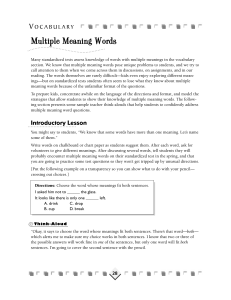
![Word Study [1 class hour]](http://s3.studylib.net/store/data/007905774_2-53b71d303720cf6608aea934a43e9f05-300x300.png)
